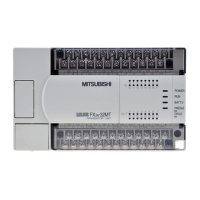7 Applied Instructions
7.23 Data Table Operation
730
FXCPU Structured Programming Manual
(Basic & Applied Instruction)
Setting example of the conversion table for scaling
A setting example for the 16-bit operation is shown below.
For the 32-bit operation, set each item using a 32-bit binary value.
In the case of the conversion characteristics for scaling shown in the figure below, set the following data table.
Setting the conversion setting data table for scaling
*1. When coordinates are specified using three points as shown in the points 4, 5 and 6, the output value
can be set to an intermediate value.
In this example, the output value (intermediate value) is specified by the Y coordinate of the point 5.
If the X coordinate is same at three points or more, the value at the second point is output also.
*2. When coordinates are specified using two points as shown in the points 8 and 9, the output value is
the Y coordinate at the next point.
In this example, the output value is specified by the Y coordinate of the point 9.
Set item
Setting device and setting contents
Remarks
When R0 is specified in
Setting
contents
Number of coordinate points R0 K10
X coordinate
Point 1
+1
R1 K5
Point 2
+2
R2 K20
Point 3
+3
R3 K50
Point 4
+4
R4 K200
Refer to *1.Point 5
+5
R5 K200
Point 6
+6
R6 K200
Point 7
+7
R7 K250
Point 8
+8
R8 K350
Refer to *2.
Point 9
+9
R9 K350
Point 10
+10
R10 K400
Y coordinate
Point 1
+11
R11 K7
Point 2
+12
R12 K30
Point 3
+13
R13 K100
Point 4
+14
R14 K25
Refer to *1.Point 5
+15
R15 K70
Point 6
+16
R16 K250
Point 7
+17
R17 K90
Point 8
+18
R18 K90
Refer to *2.
Point 9
+19
R19 K30
Point 10
+20
R20 K7
Point 1 (5,7)
X
Y
Point 2
(20,30)
Point 3
(50,100)
Point 5
(200,70)
Point 4(200,25)
Point 6(200,250)
Point 7
(250,90)
Point 8(350,90)
Point 9
(350,30)
Point 10(400,7)

